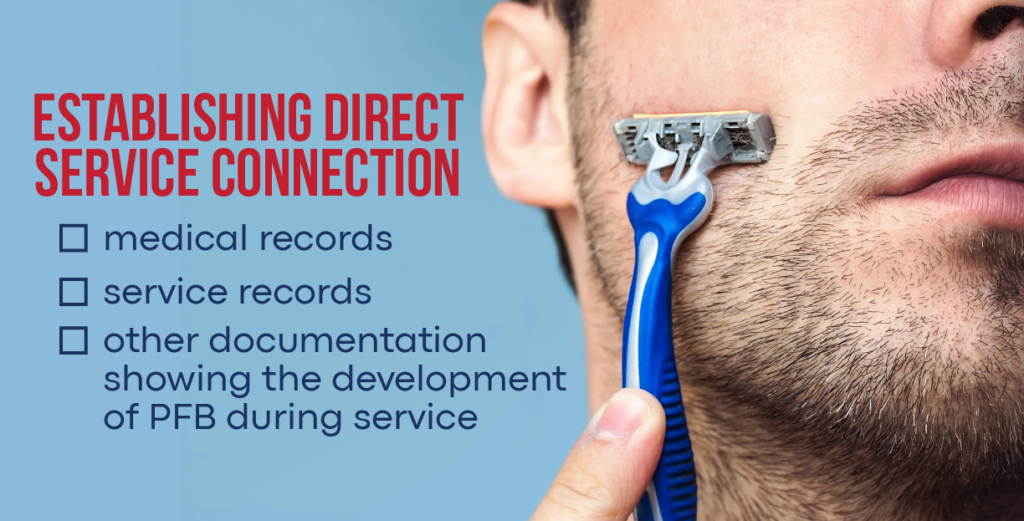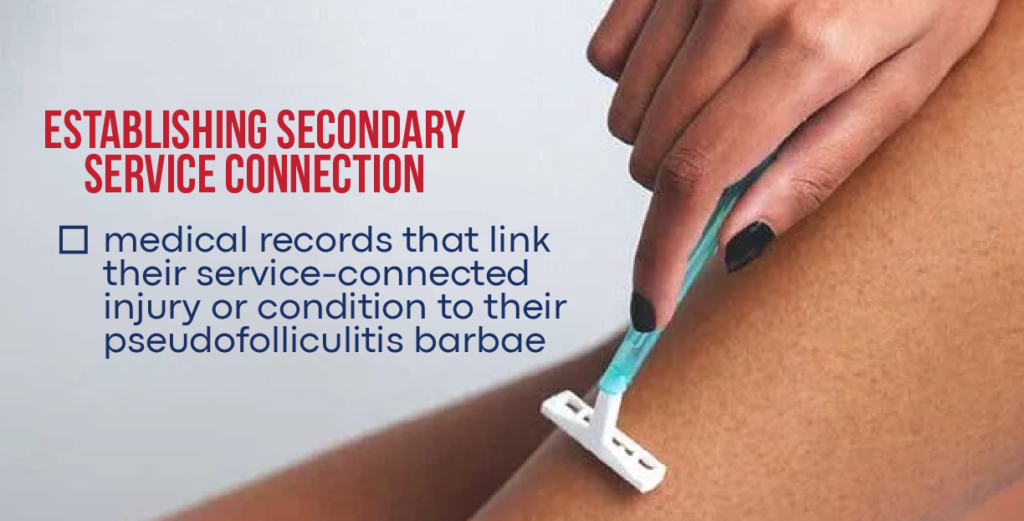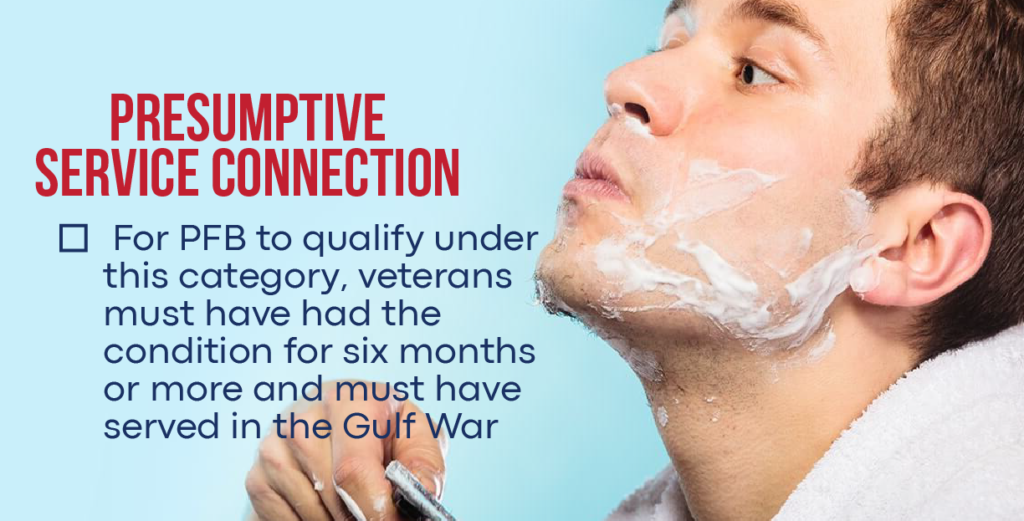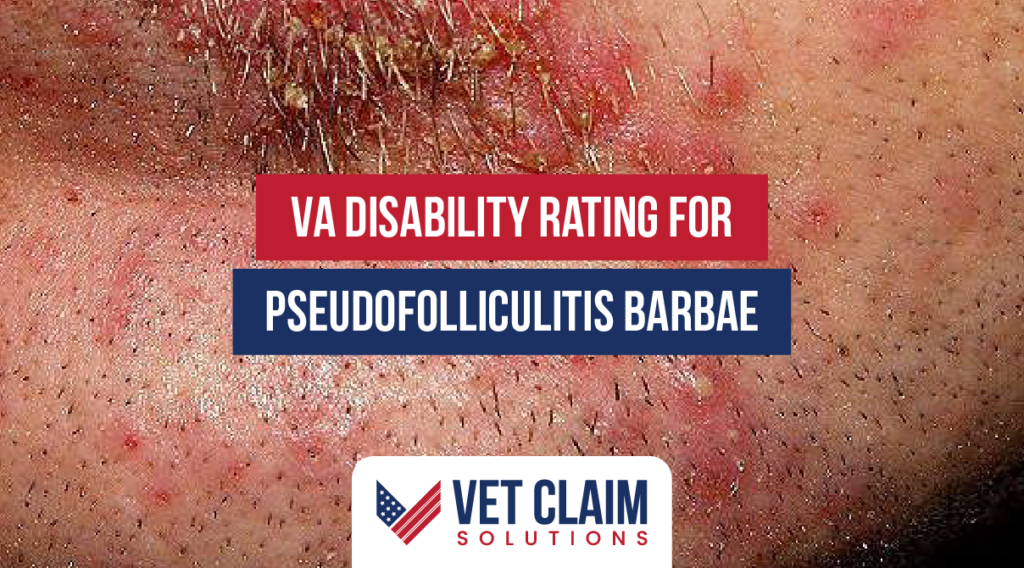Pseudofolliculitis Barbae, more commonly known as “razor bumps,” is a common skin condition that causes inflammation and irritation around the hair follicles. It can cause severe discomfort for veterans, which is why the Department of Veterans Affairs (VA) offers disability benefits and ratings for this condition. This article will discuss the VA rating for pseudofolliculitis barbae.
Read on to learn more about the VA’s disability rating system for Pseudofolliculitis Barbae and how to receive VA disability.
Overview of Pseudofolliculitis Barbae and its Symptoms

Pseudofolliculitis barbae is a medical condition resulting from ingrown hairs trapped beneath the skin surface, causing inflammation, redness, and pus-filled cysts in the beard skin or other areas of the head, face, and neck.
While this condition is the most common in black and Hispanic men, it can occur anywhere on the body. It is important to note that pseudofolliculitis barbae can also result from other underlying skin conditions.
Symptoms of pseudofolliculitis barbae include redness, inflammation, and pus-filled cysts in the face, neck, and scalp. It can also lead to scarring of the underlying soft tissue. Those with coarser hair are more likely to develop the condition.
How to determine if you meet the criteria for a VA rating
If you are a veteran diagnosed with pseudofolliculitis barbae or PFB, and you’d like to know if you qualify for VA benefits, understanding how to establish a service connection is key. VA disability benefits are available for veterans who can prove that the condition was either incurred or aggravated while they were serving in the military. The three ways to establish a service connection include direct service connection, secondary service connection, and presumptive service connection.
Direct Service Connection
The most common way of establishing a service connection for PFB is through a direct service connection. This means veterans must provide evidence that links the onset or aggravation of their PFB to their military service. Such evidence may include medical records, service records, and other documentation showing they developed PFB while serving in the military. Even if there is no diagnosis of pseudofolliculitis barbae in the veteran’s service treatment records, they may still be able to establish direct service connection if they can show they were experiencing symptoms of PFB during their military service.

Secondary Service Connection
Secondary service connection applies to those veterans who have a condition that is already service-connected and which has caused or aggravated the PFB. To be approved for a VA rating under this connection, veterans must provide medical records that link their service-connected injury or condition to their pseudofolliculitis barbae. In some cases, it may be possible to file for benefits for both conditions at the same time – such as if a service-connected disability requires taking medication that aggravates the PFB.

Presumptive Service Connection
The VA offers presumptive service connection to certain medical conditions, including pseudofolliculitis barbae. For PFB to qualify under this category, veterans must have had the condition for six months or more and must have served in the Gulf War. Veterans can be approved for a VA disability rating if they can demonstrate this criterion and link their PFB to an undiagnosed illness or medically unexplained chronic multisystem illness.

What evidence is needed to support your claim
If you suffer from pseudofolliculitis barbae (PFB) and are seeking VA disability benefits, there are three primary criteria that need to be met in order for the VA to rate your condition. The first is that a medical diagnosis of PFB must be present. Second, it must be established through medical evidence (either your military service records or a private diagnosis) that you had an in-service event, injury, or exposure that led to your development of PFB or the worsening of existing PFB. Third, there must be a link (or nexus) between the in-service event and the subsequent development of PFB; this is known as a service connection.
How the VA Rates Pseudofolliculitis Barbae
The VA uses two methods to assign a pseudofolliculitis barbae (PFB) VA rating.
1 . The General Rating Formula for the Skin and
2. Scars caused by PFB.
General Rating Formula
The General Rating Formula assigns ratings based on the percentage of skin area impacted by the condition and whether systemic therapy (such as corticosteroids, phototherapy, retinoids, etc.) has been necessary for treatment over the past 12-month period.
Veterans can be awarded a 60%, 30%, or 10% rating if they meet the criteria for each level. Here are the criteria for each rating:

characteristic lesions involving more than 40% of the entire body or more than 40% of exposed areas affected, and near-constant systemic therapy over the past 12-month period.

characteristic lesions involving 20 to 40% of the entire body or 20 to 40% of exposed areas affected, and systemic therapy required for a total duration of more than six weeks over the past 12-month period.

characteristic lesions involving at least 5% but less than 20% of the entire body affected; or at least 5% but less than 20% of exposed areas affected, and intermittent systemic therapy required for a total duration of fewer than six weeks over the past 12-month period.

characteristic lesions involving less than 5% of the entire body affected, and no more than topical therapy required over the past 12-month period.
Scars caused by PFB
In addition to the General Rating Formula, VA may also assign a rating to veterans based on any scars they have developed due to PFB. Here are the ratings that can be assigned for scars caused by PFB:

If a veteran has visible or palpable tissue loss, resulting in gross distortion or asymmetry of facial features such as the nose, chin, forehead, eyes (including eyelids), ears (auricles), cheeks, and lips, they may be eligible for a 30% rating.

If the scarring is more subtle, such as one characteristic disfigurement, VA may assign a 10% rating.
C&P Exams for pseudofolliculitis barbae
Veterans seeking a VA disability rating for pseudofolliculitis barbae may need to undergo a C&P Exam in order to make their claim. During this exam, the veteran will be asked about their military service, medical history, and current disability rating. The doctor may also examine any exposed areas affected by the condition, or any underlying soft tissue, in order to get a better understanding of the severity of the condition.
The examiner will then make a recommendation for VA disability benefits and a rating based on their findings. It is important for the veteran to answer all questions honestly and accurately so that an accurate assessment of the condition can be made, and the VA can issue them with the highest rating possible.
Need Help with Filing a VA Disability Claim

If you need help with filing a VA claim for pseudofolliculitis barbae or any other disability, Vet Claim Solutions can assist. Our Claim Coaches have the expertise and experience to make sure your claim is filed correctly so that you can get the VA disability benefits you are entitled to. Contact us today for more information on how we can help.
We’re dedicated to helping veterans with their disability claims and ensuring they receive the VA disability benefits they deserve. Don’t wait. Contact us today.
FAQ’s
1. Can you get VA disability for folliculitis?
Yes, veterans with folliculitis may be eligible for VA disability benefits. Eligibility depends on the severity of the condition and whether systemic therapy (such as corticosteroids, phototherapy, retinoids, etc.) has been necessary for treatment over the past 12-month period.
2. What is the VA rating for Barbae?
The VA rating for Barbae depends on the severity of the condition and any scars caused by it. Ratings are typically assigned from 0-30%, depending on how much of the body is affected, whether systemic therapy has been necessary for treatment over the past 12-month period, and whether there is visible or palpable tissue loss resulting in gross distortion or asymmetry of facial features. A C&P exam may be necessary to determine the exact rating.
3. Can you get VA disability for PFB?
Yes, you can get VA disability for PFB if your condition meets the criteria laid out by the General Rating Formula or the Scar rating. You may also need to undergo a C&P Exam in order for your claim to be approved.
4. What is the Diagnostic Code for Pseudofolliculitis Barbae?
For VA disability rating purposes, PFB is usually classified under Diagnostic Code 7806 using the general rating formula for the skin. In cases where scarring results from PFB on the head, face, or neck area, veterans may be eligible for a higher VA rating based on Diagnostic Code 7800.


